今回の「英語で東京を案内してみよう」シリーズは「明治神宮」をピックアップしていきます!
今年の1月20日から始まった、2020年の明治神宮鎮座百年祭最後の記念事業である南参道の第一鳥居の建替え工事も6月末で終了しました。
歴史的建造物が多い日本の中で、創建してから100年余りの明治神宮は、むしろ新しいくらいかもしれませんが、例年初詣の参拝客が日本一であるように、明治神宮には人々を惹きつけてやまない魅力やパワーがとても強いですよね。
明治神宮は海外の人たちにも大人気です!
都会のオアシスのような明治神宮は、何も知らずに訪れても十分に癒やされ、満足できる観光スポットだと思いますが、ぜひ「明治神宮」についてのあれこれを海外の人たちに英語で説明して、明治神宮の素晴らしさをより深く知ってもらいましょう!
かなりのボリュームになってしまったので、前編・後編に分けてお送りします!

【ガイドライター】
齋藤 一美(さいとう かずみ)
—————–
2016年に英語全国通訳案内士資格取得。通訳ガイド派遣会社でのコーディネーター職を経てフリーランスの通訳ガイドに。コロナ禍の現在は前職の介護福祉士として高齢者ケアの仕事に従事中。グーグルマップを見ながら妄想旅のプランをあれこれ練ってるときが至福の時間。
明治神宮の案内にチャレンジしてみよう!
原宿駅を出て南参道入口からのガイディング例です。なるべく多めの情報をシェアするためにかなりのボリュームになっていますが、もちろん全てを案内する必要はありません!ぜひ使いたい情報だけピックアップしてください。
また、そのままの英文を覚えるのもよいですが「自分が言いやすい英文」にカスタマイズするのがおすすめです。
明治神宮の概要について
▶「明治神宮」は、今上天皇より四代前の第122代天皇である明治天皇と昭憲皇后が御祭神の神道の神社です。

“Meiji Jingu” is a Shinto shrine that enshrines Emperor Meiji, the 122nd emperor, four generations before the Present Emperor, and Empress Shoken.
▶1912年に明治天皇がご崩御されてから、御神霊をお祀りしたいという国民の熱い願いが沸き起こり、1920年に明治神宮は創建されました。

After the demise of Emperor Meiji in 1912, the people’s passionate desire to worship his spirit arose, and Meiji Jingu was established in 1920.
▶ところで、「初詣」といい、新年を迎えると多くの日本人が神社を参拝します。そして明治神宮は、全国で最も初詣の参拝客が多い神社です。毎年お正月の三日間に300万人以上の人々が訪れます。

By the way, when the New Year comes, many Japanese people visit shrines to pray. It’s called “Hatsumode”. And Meiji Jingu is the shrine with the largest number of people visiting on the New Year. More than 3 million people visit this shrine each year during the first three days of the New Year.
▶明治神宮の境内は約70万㎡あり、そのほとんどのエリアは木々で覆われていています。明治神宮は人々にとって都会のオアシスのような存在です。

The precincts of Meiji Jingu are about 700,000 square meters, and most of the area is covered with trees. Meiji Jingu is like an oasis in the city for people.
▶明治神宮では開門時間は日の出、そして閉門時間は日の入りの時間に合わせているため、月によって開閉時間が変わります。

At Meiji Jingu, the opening time is adjusted to sunrise and sunset, so the opening and closing time varies depending on the month.
▶最も日が長い6月は5:00〜18:30、最も日が短い12月は6:40〜16:00です。

June has the longest days with the opening hours from 5am to 6:30pm, and December has the shortest days with the opening hours from 6:40am to 4pm.
南参道入口にて
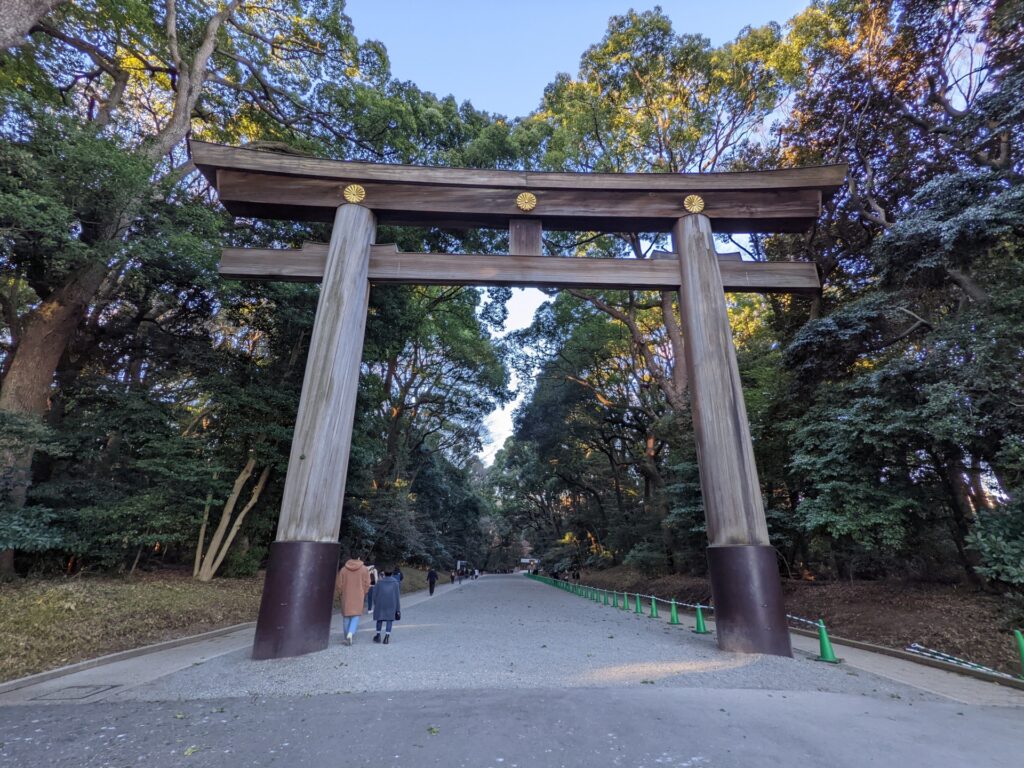
▶明治神宮への入口は3か所あります。こちらは「南参道入口」で最も多くの人が利用します。

There are three entrances to Meiji Jingu. This is the “entrance to Minami Sando or the southern approach” that is used by most people.
▶ここから本殿までは歩いて10分ほどです。

It takes about 10 minutes on foot from here to the main shrine.
▶この大きな門は「鳥居」といいます。たいてい神社の入口にあり、神域と私たちが暮らす俗世との境界を表しています。

This big gate is called “Torii”. In general, It is located at the entrance of a shrine, it represents the boundary between the sacred area and the world in which we live.
▶そして、こちらの鳥居、「南参道の第一鳥居」は、先代の鳥居が100年間の役割を終えた後、2022年6月末に建替工事が終了したばかりの新しい鳥居です。

And, this torii, “The First Torii of the southern approach” is a new torii that has just been rebuilt at the end of June 2022 after the previous torii finished its role for 100 years.
▶建替工事期間は約半年でしたが、鳥居にふさわしい用材を探したり、木を乾燥させたりなど、全ての行程に要した期間は約8年掛かりだったとのことです。

The rebuilding period was about half a year, but it took about eight years for the entire process, such as searching for suitable materials for the torii gate and drying the trees.
▶奈良県の吉野にある樹齢250年の吉野杉でつくられています。

It is made from 250-year-old Yoshino cedar in Yoshino, Nara Prefecture.
▶大きな神社だと本殿までにいくつかの鳥居があります。明治神宮もこちらの鳥居を含めて本殿までに3つの鳥居をくぐります。

The large shrine has several torii gates up to the main shrine. Meiji Jingu also goes through three torii gates to the main shrine, including this torii gate.
▶鳥居の上部にある金色のマークは「菊花紋章」といい、天皇家の家紋です。

The golden marks at the top of the torii are called the “Imperial Chrysanthemum Crest” which is the family crest of the Emperor.
▶日本人の多くは鳥居をくぐる前に、神様への礼としてお辞儀をします。

Many Japanese bow as a greeting to Kami (deity) before going through the torii gate.
▶参道の真ん中は神様の通り道といわれています。日本人でも知らない人は真ん中を歩いていますが端を歩きましょう!

It is said that the center of the approach is the path for Kami. Even Japanese people who don’t know about it are walking in the center, but let’s walk on the edge of the approach!
明治神宮の杜について
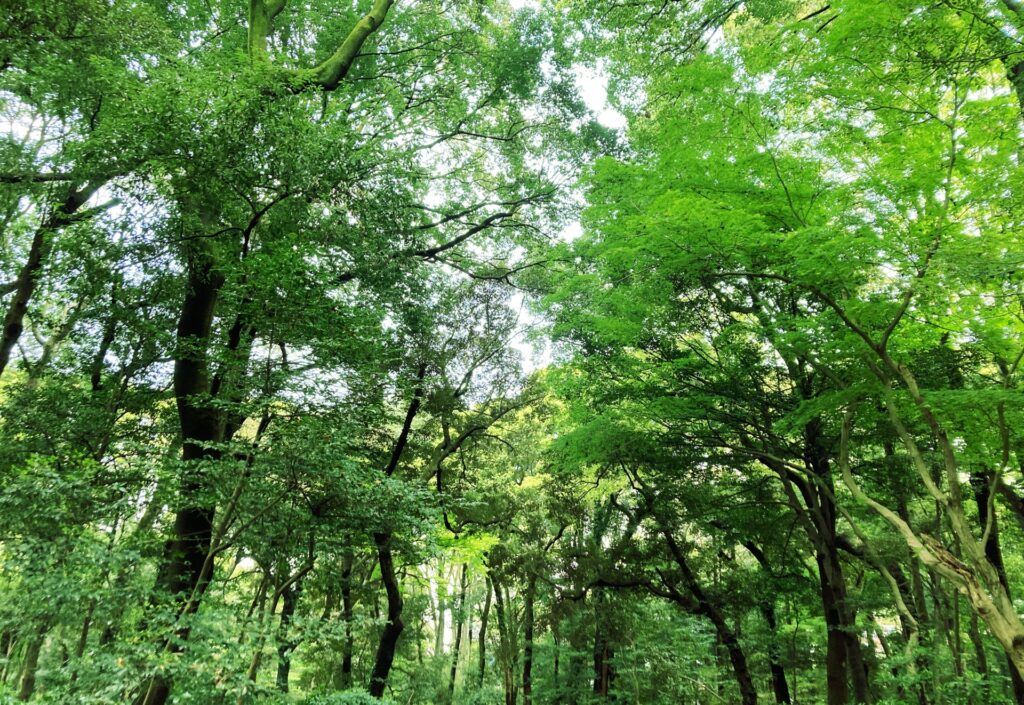
▶想像できないと思いますが、明治神宮が創建される前のこの辺りには木などほとんど生えておらず、荒れ地のような景観が広がっていました。

Believe it or not, before the Meiji Jingu was built, there were almost no trees around here, and the scenery was like a wasteland.
▶明治神宮の杜は人工林なんです!全国からの365種約10万本の献木と、延べ11万人の青年団による勤労奉仕でつくり上げられました。

The forest of Meiji Jingu is a man-made forest! It was created by donating about 100,000 trees of 365 species from all over the country and working service by a total of 110,000 youth groups.
▶ところで神社にとって、杜は不可欠な構成要素であり、一般的に神社にふさわしい樹木は杉や檜などの針葉樹といわれています。

By the way, forests are indispensable components for shrines, and suitable trees for shrines are generally said to be coniferous trees such as cedar and cypress.
▶しかし人工林の造営を任されていた林学の第一人者たちは、暖帯で煙害もある都会の地には針葉樹は適していないと判断しました。

However, the leading experts in forestry, who were entrusted with the construction of the man-made forest, figured that conifers were not suitable for urban areas that were warm and smoke-damaged.
▶そして、当初は成長の早い針葉樹も植林しつつ、この地に適している樫、椎、楠などの広葉樹を中心に植林することを決定しました。

And, they decided to plant mainly broad-leaved trees such as oak, castanopsis, and camphor trees that are suitable for this area, while also planting fast-growing coniferous trees initially.
▶学者たちは、それらの広葉樹が後に主木となっていき、手入れや施肥など皆無で「永遠の杜」を形成できるという科学的な想定をしました。

The scholars made the scientific assumption that these broad-leaved trees will later become the main trees and can form an “eternal forest” with no care or fertilization.
▶そして明治神宮の杜は、参道を掃いて集めた落ち葉を森に戻す以外は人為的な手はいっさい加えず、見事に自然林化されています。

And then, the forest of Meiji Jingu has been excellently made into a natural forest without any artificial work other than returning the fallen leaves collected by sweeping the approach to the forest.
明治神宮ミュージアムについて
▶こちら右手の建物は「明治神宮ミュージアム」です。明治神宮の創建100年を記念して2019年に開館しました。

The building on the right is the “Meiji Jingu Museum”. It opened in 2019 to commemorate the 100th anniversary of the establishment of Meiji Jingu.
▶明治天皇と昭憲皇后のゆかりの品々を保管、展示しています。

Items related to Emperor Meiji and Empress Shoken are stored and exhibited.
▶建物は、世界的に有名な建築家である隈研吾氏のデザインです。

The building is designed by Kengo Kuma, a world-famous architect.
▶入館料は大人1,000円です。

The admission fee is 1,000 yen for adults.
酒樽とワイン樽について

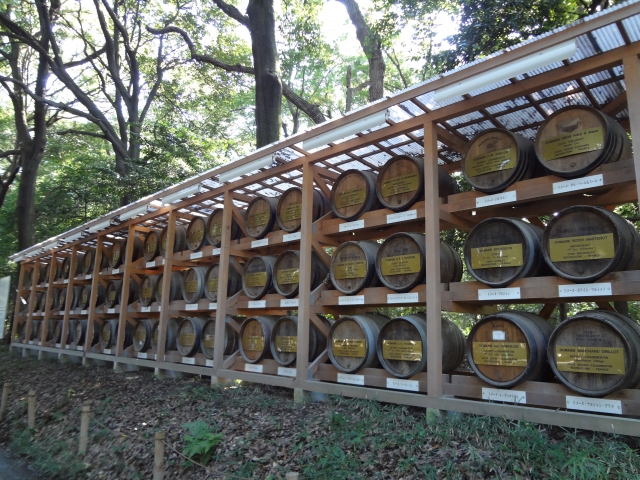
▶両側に大きな棚が見えてきました!

Now you can see big shelves on both sides!
▶右側の棚に並んでいるのは酒樽です。全国の酒造会社から奉納されたものです。

The sake barrels are lined up on the right shelf. These are dedicated by sake brewing companies nationwide.
▶日本酒は、神様にお供えする神聖な飲み物として扱われています。

Sake is treated as a sacred drink for Kami.
▶樽は72リットルのお酒が入るサイズです。全部で216の樽が並んでいます。

The barrel is sized to hold 72 liters of sake. There are 216 barrels in all.
▶多くの神社で酒樽の陳列は見られますが、明治神宮の酒樽の数は群を抜いています。

You can see the display of barrels at many shrines, but the number of barrels at Meiji Jingu is outstanding.
▶左側の棚に並んでいるのはワイン樽です。神社にワイン樽があるのはとても珍しいです。おそらく明治神宮だけでしょう。

Lined up on the left shelf are wine barrels. It is very rare for a shrine to have wine barrels. Probably only Meiji Jingu.
▶明治天皇は、断髪して洋装したり、洋食を召し上がられたりと、積極的に西洋文化を取り入れ近代化を先導した「文明開化」のシンボル的な存在でした。

Emperor Meiji was a symbol of “Bunmei Kaika or civilization and enlightenment” who actively adopted Western culture and led modernization by cutting hair, dressing up in Western-style, and eating Western food.
▶そして明治天皇はワインも好んで嗜まれていました。

And Emperor Meiji also liked wine.
▶そういった理由から、フランス・ブルゴーニュの名誉市民である日本人の呼びかけにより、2006年よりブルゴーニュ地方のワイン醸造元からの奉納が始まりました。

For those reasons, the dedication from the winemakers in the Burgundy region began in 2006 at the request of the Japanese, who are honorary citizens of Burgundy, France.
▶ちなみに酒樽もワイン樽も中は空っぽです。これらは飾り用の樽で、中の日本酒やワインは別に奉納されているとのことです。

By the way, both the sake barrel and the wine barrel are empty. These are barrels for decoration, and the sake and wine inside are dedicated separately.
大鳥居(第二鳥居)にて
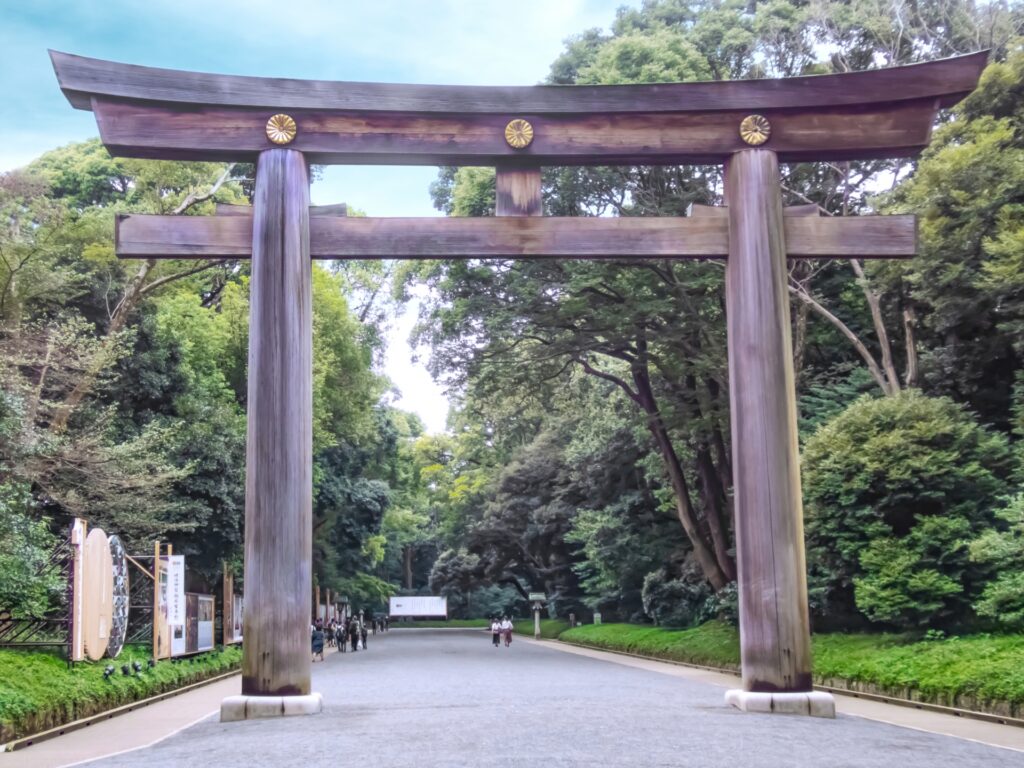
▶こちらの鳥居は大鳥居、あるいは第二鳥居です。木造の明神鳥居としては日本一の大きさです。

This is “Ootorii”, the Great torii or second torii gate. It is the largest torii of its kind which is a wooden Myojin-style torii in Japan.
▶柱は直径1.2メートル、高さ12メートル、重さ13トンで、樹齢1500年を超える、台湾で発見された大檜でつくられています。

The pillars are 1.2 meters in diameter, 12 meters in height, and 13 tons in weight, and are made of Japanese cypress found in Taiwan, which is over 1500 years old.
▶現在の大鳥居は1975年に再建された2代目です。先代の大鳥居も台湾で伐採された樹齢1200年を超える大檜で造られていましたが、1966年に落雷によって破損してしまいました。

The current Ootorii is the second generation reconstructed in 1975. The previous Otorii was also made of Japanese cypress, which was cut down in Taiwan and is over 1200 years old, but it was damaged by a lightning strike in 1966.
▶️先代の大鳥居は破損した翌年に修復され、他の神社の鳥居として活用されています。(埼玉県、大宮の氷川神社)

The previous Ootorii was restored the year after it was damaged and it is being used as a torii gate for another shrine.
明治神宮御苑について
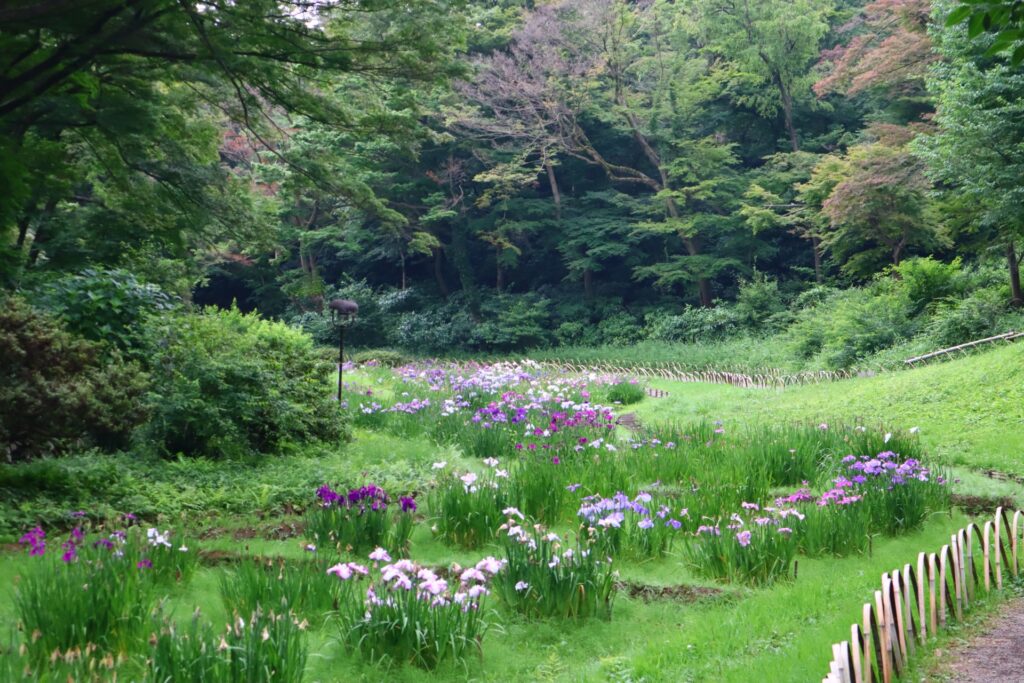
▶左手にある門は明治神宮の庭園「御苑」の入口です。御苑の維持費として入園料500円となっています。

The gate on the left is the entrance to the garden “Gyoen” at Meiji Jingu. The entrance fee is 500 yen as the maintenance fee for the garden.
▶元々この御苑の土地は、江戸時代には大名の下屋敷の庭園でした。そして明治時代に入り御料地になり、明治天皇が身体の弱かった皇后のために遊歩庭園として整備しました。

Originally, the land of this garden was the garden of a daimyo’s residence in the Edo period. Then, in the Meiji era, it became an imperial estate, and Emperor Meiji maintained it as a walking garden for the empress who was physically weak.
▶この御苑は、唯一、明治神宮の創建前から樹木が生えていた場所です。

This garden is the only place where trees were growing before Meiji Jingu was established.
▶明治天皇の指示により庭園内には皇后がお好きだった花菖蒲が約80種類植えられました。

According to the instructions of Emperor Meiji, about 80 kinds of irises that the Empress liked were planted in the garden.
▶現在は約150種1500株に増え、5月下旬頃から6月中旬頃のシーズンには美しい花菖蒲が咲き誇っています。

Currently, the number has increased to 1500 stocks of about 150 species, and beautiful irises are in full bloom during the season from late May to mid-June.
▶御苑内には「隔雲亭」という、明治天皇が昭憲皇后のために建てられたという数寄屋造りの木造家屋があります。しかしオリジナルは戦火で焼失し、現在の建物は1958年に建て替えられたものです。

In the garden, there is a wooden house called “Kaku-un-tei”, which is a sukiya-style house built by Emperor Meiji for Empress Shoken. However, the original was burned down in the war and the current building was rebuilt in 1958.

▶また、御苑内には「清正井」という、加藤清正という歴史上有名な武将が掘ったと伝えられている井戸があり、都内有数の名湧水なんです。井戸水の温度は年間を通して15度前後です。

In addition, there is a well in the garden called “Kiyomasa no Ido”, which is said to have been dug by a famous military commander named Kiyomasa Kato. This well is one of the most famous springs in Tokyo. The temperature of well water is around 15 degrees throughout the year.
▶そして、この井戸はパワースポットとしてとても有名で、自分で撮った井戸の画像を待ち受け画面に設定すると運気がアップすると言われています。

And this well is very famous as a spiritual place, and it is said that if you take a picture of the well and set it as your phone wallpaper, your luck will improve.
この辺で、前編はおしまいです。
次回の後編では、外拝殿や夫婦楠の説明から、参拝の仕方など、まだまだ盛りだくさんの内容をお届けします。
お楽しみに!
E-learningで明治神宮のガイディングが学ぼう!
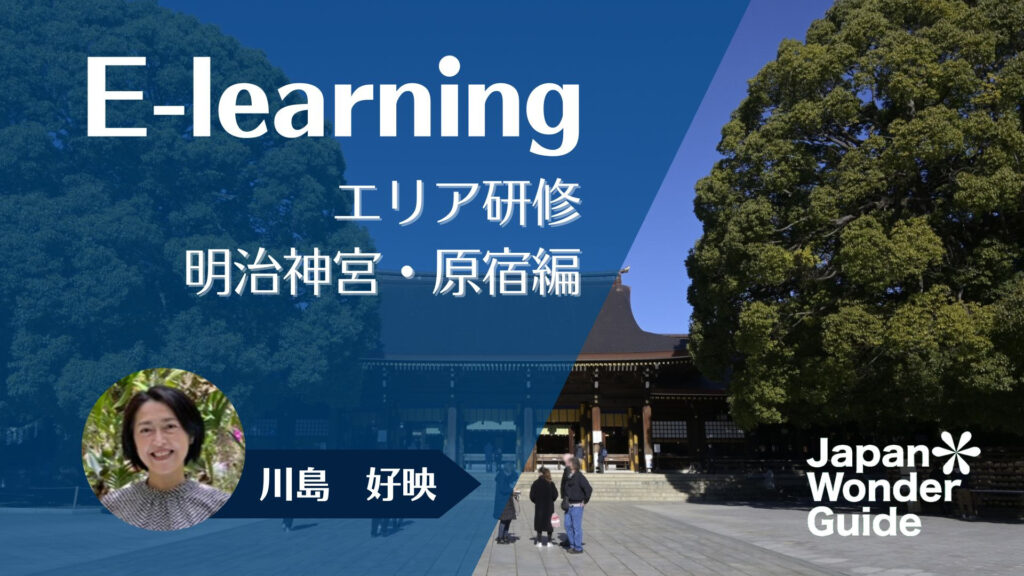
JapanWonderGuide Campusでは、ご自宅でご受講いただける研修動画E-learningで、エリア研修明治神宮・原宿編を配信しています。ツアーの定番である明治神宮や原宿の概要をもっと知りたい方、案内してみたい方、ガイディングポイントを確認したい方はぜひご覧ください!
また、1講座1500円でご受講いただけますが、有料会員Knottistになっていただくと、会員費月額1,000円(税抜)ですべてのE-learningが見放題となります。
エリア研修だけでなく、仏教や神道、美術史などのテーマ研修やコミュニケーション研修など、ガイディングに役立つ様々な研修動画が揃っていますので、1本以上見てみたい!という方は、ぜひKnottistへの入会もご検討ください。

英語で東京案内シリーズ
ガイドコミュニティ・JapanWonderGuideに参加しませんか?
JapanWonderGuide(JWG)は「日本のガイドの質を世界一に」をスローガンに掲げるガイドコミュニティです。
2020年から活動を開始し、全国通訳案内士等を中心に、現在は、3,800名を超えるコミュニティとなっております。
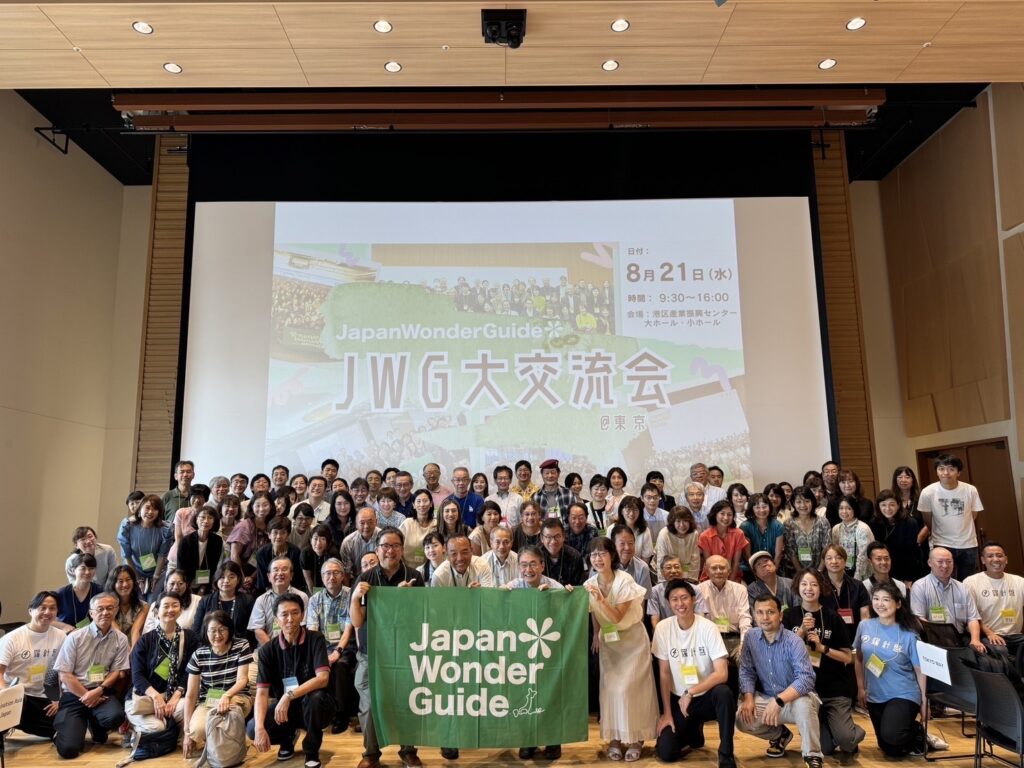
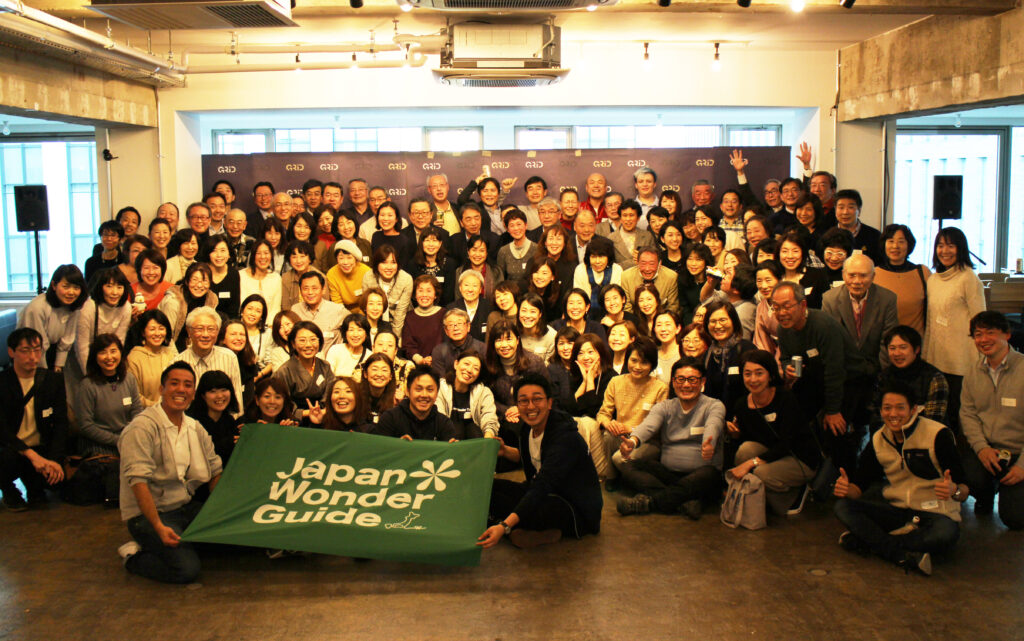
JWGの有料会員(Knottist)にご登録いただくと、月額1,000円(税込1,100円)で、ガイディングやビジネスに活きる知識・スキルが身につくE-Learningが受講し放題!ガイドのスキルアップに特化した研修動画を、お好きなだけ、無料でご視聴いただけます。
さらに、Knottistになると、通訳案内士が5年ごとに必ず受講しなければならない「通訳案内研修」を、オンラインで、無料でご受講いただけます。そのほか、下見やツアー時に割引/無料でご入場いただける優待施設のご利用や、人気観光施設の最新情報や裏話をお届けするJWG Live!の見逃し配信、各研修の割引など、様々な特典をご利用いただけます。
有料、無料会員様ともに研修やイベント情報など、ガイドに役立つ内容がたっぷり詰まったメルマガを月に2回お届け。
また、ガイド仲間を見つけ、交流できるFacebookグループにもご招待!情報交換の場としてお使いください。
| Knottist Free | Knottist | Knottist+ | |
| 料金 | 無料! | 月額1,000円 (税込1,100円) | 年間14,000円※ (税込15,400円) |
| 期間 | 無期限 | 毎月自動更新 | 2026年8月31日まで |
| ①E-learning動画配信 | 有料 | 無料 | 無料 |
| ②メンバー向けメルマガ受信 | ○ | ○ | ○ |
| ③JWG Live!見逃し配信 | △ | ○ | ○ |
| ④JWG主催研修割引 | – | ○ | ○ |
| ⑤JWG交流会へご招待 | 有料 | 無料 | 無料 |
| ⑥通訳案内研修 | 3,500円 | 無料 | 無料 |
| ⑦E-learning動画配信 | 有料 | 無料 | 無料 |
| ⑧メンバー限定Facebookグループご招待 ※ご希望される場合のみ | 〇 | 〇 | 〇 |
| ⑨通訳ガイド保険 | – | – | ○ |
※Knottist+の会費は加入月によって変動します
★通訳ガイド保険がついたKnottist+もご用意しております。資格の保有の有無に関わらず、通訳案内業務が補償の対象となりますので、どなたでも安心してガイドのお仕事をしていただけます。
インバウンド復活の兆しも少しずつ見えてきました。ぜひこの機会にご検討ください。
まずKnottist Free (フリーメンバー)に登録し、月2回メルマガを受け取ってみませんか?
JWGで、日本の観光を一緒に盛り上げていきましょう!







コメント